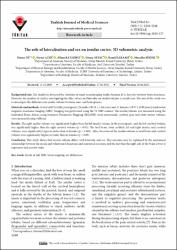| dc.contributor.author | Öz, Fatma | en_US |
| dc.contributor.author | Acer, Niyazi | en_US |
| dc.contributor.author | Katayifçi, Nihan | en_US |
| dc.contributor.author | Aytaç, Güneş | en_US |
| dc.contributor.author | Karaali, Kamil | en_US |
| dc.contributor.author | Sindel, Muzaffer | en_US |
| dc.date.accessioned | 2021-07-16T12:01:42Z | |
| dc.date.available | 2021-07-16T12:01:42Z | |
| dc.date.issued | 2021 | en_US |
| dc.identifier.citation | Öz, F., Acer, N., KATAYIFÇI, N., Aytaç, G., Karaali, K., & Sindel, M. (2021). The role of lateralisation and sex on insular cortex: 3D volumetric analysis. Turkish journal of medical sciences, 51(3), 1240-1248. | en_US |
| dc.identifier.issn | 1300-0144 | |
| dc.identifier.issn | 1303-6165 | |
| dc.identifier.uri | https://doi.org/10.3906/sag-2010-137 | |
| dc.identifier.uri | https://hdl.handle.net/20.500.12294/2786 | |
| dc.description.abstract | Background/aim: The insula has attracted the attention of many neuroimaging studies because of its key role between brain structures. However, the number of studies investigating the effect of sex and laterality on insular volume is insufficient. The aim of this study was to investigate the differences in insular volume between sexes and hemispheres. Materials and methods: A total of 47 healthy participants [24 males (20.08 +/- 1.44 years) and 23 females (19.57 +/- 0.90 years)] underwent magnetic resonance imaging (MRI). Imaging was performed using the 3T MRI scanner. The insular volume was measured using the Individual Brain Atlases using Statistical Parametric Mapping (IBASPM); total intracranial, cerebral, grey and white matter volumes were measured using volBrain. Results: The right insular volume was significantly higher than the left insular volume in the participants, and the left cerebral volume was significantly higher than the right cerebral volume (p < 0.05). The total brain, total cerebral, left and right insular, and cerebral volumes were significantly larger in males than in females (p < 0.001). Also, the ratios of the insular volume to total brain and cerebral volume were significantly higher in males than in females (p < 0.05). Conclusion: This study shows that insular volume differs with laterality and sex. This outcome may be explained by the anatomical relationship between the insula and behavioural functions and emotional reactions and the fact that the right side of the brain is best at expressive and creative tasks. | en_US |
| dc.language.iso | eng | en_US |
| dc.publisher | TUBITAK Scientific & Technical Research Council Turkey | en_US |
| dc.relation.ispartof | Turkish Journal of Medical Sciences | en_US |
| dc.identifier.doi | 10.3906/sag-2010-137 | en_US |
| dc.identifier.doi | 10.3906/sag-2010-137 | |
| dc.rights | info:eu-repo/semantics/openAccess | en_US |
| dc.rights | Attribution-NoDerivs 3.0 United States | * |
| dc.rights.uri | http://creativecommons.org/licenses/by-nd/3.0/us/ | * |
| dc.subject | Insula of Reil | en_US |
| dc.subject | Brain Mapping | en_US |
| dc.subject | Sex Differences | en_US |
| dc.subject | MRI | en_US |
| dc.title | The Role of Lateralisation and Sex on Insular Cortex: 3D Volumetric Analysis | en_US |
| dc.type | article | en_US |
| dc.department | Tıp Fakültesi, Temel Tıp Bilimleri Bölümü | en_US |
| dc.authorid | 0000-0002-4155-7759 | en_US |
| dc.identifier.volume | 51 | en_US |
| dc.identifier.issue | 3 | en_US |
| dc.identifier.startpage | 1240 | en_US |
| dc.identifier.endpage | 1248 | en_US |
| dc.relation.publicationcategory | Makale - Uluslararası Hakemli Dergi - Kurum Öğretim Elemanı | en_US |




















